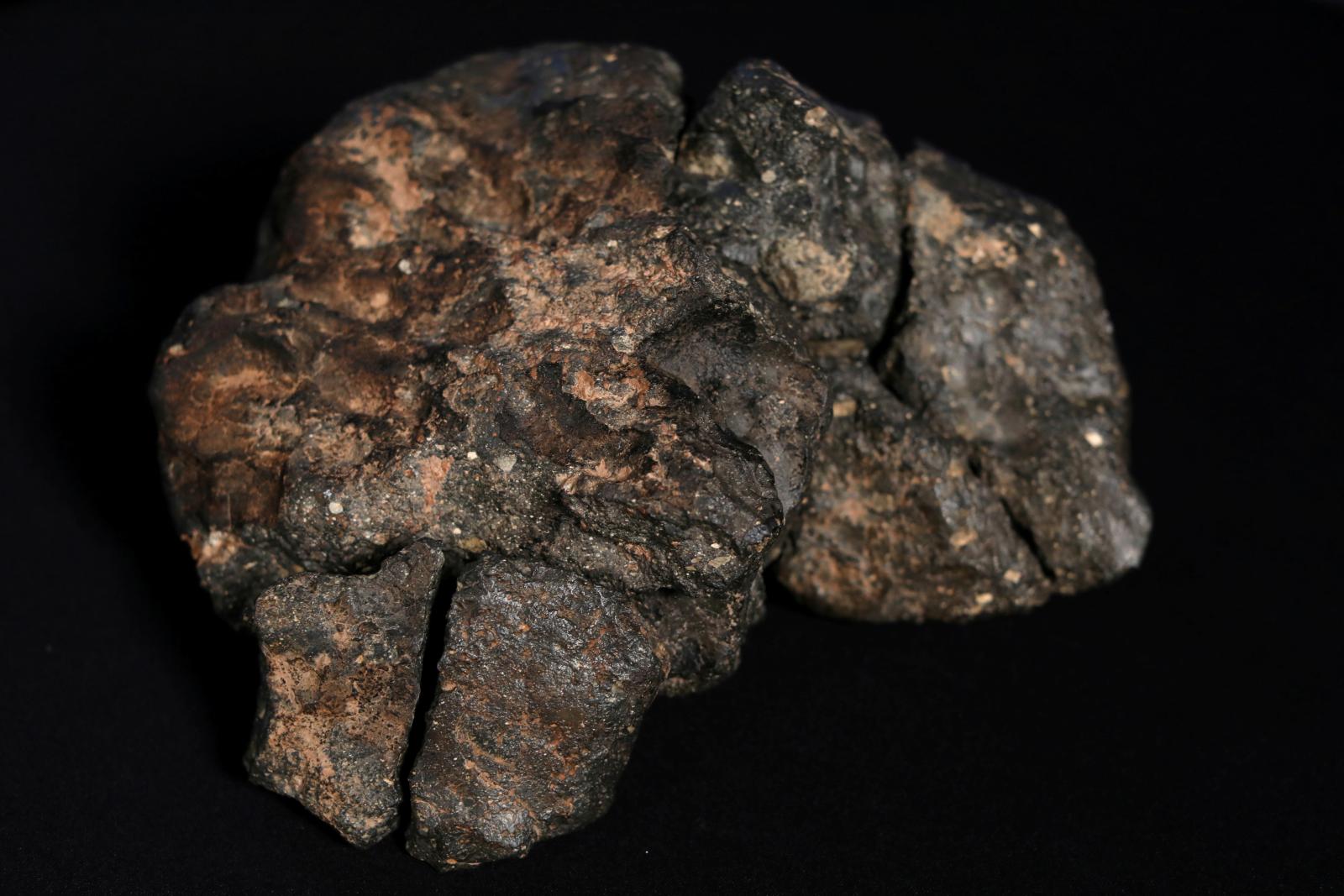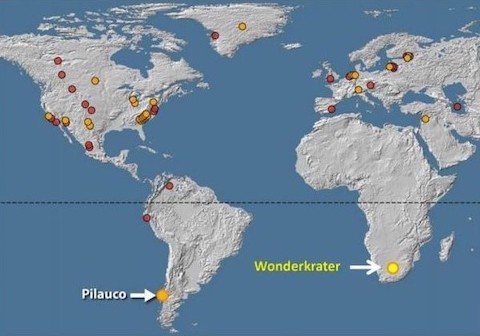
Credit: Francis Thackeray (University of the Witwatersrand)
Earth has experienced dozens of ice ages in the past few million years. At the coldest point of the most recent one, ice sheets over a thousand feet thick covered much of North America.
Then, 15,000 years ago, the world began to warm, and ice started melting—until 13,000 years ago, when Earth plunged back into the Ice Age for a thousand more years.
Scientists thought this may have been caused by trillions of gallons of cold glacial meltwater flooding out into oceans, interrupting the warmer surface currents that heat the continents.
But recently, they found platinum in sediments in several places around the world, all correlating to that time when Earth began cooling again. Some thought this may have been caused by a meteorite impact dispersing platinum into the atmosphere.
While some meteorites contain platinum, most are also high in iridium. But they found no iridium in these deposits.
A debate began, sending teams to analyze sediments around the world. Many of them showed a platinum spike from that same period.
The search is now on for the impact zone of a huge, rare magmatic iron meteorite, which contains little iridium. If and when they find it, you’ll hear about it on a future EarthDate.
After that 1200-year cold snap, Earth warmed dramatically—in as few as 40 years. And stable mild temperatures for the last 12,000 years have allowed the flourishing of all civilization on Earth.
Background
Synopsis: As the Pleistocene Ice Age was dwindling, Earth started on a warming trend. But about 12,900 years ago, the planet suddenly cooled back down to ice age temperatures for a 1200-year period called the Younger Dryas. Some researchers have attributed the change to glacial outburst impacting oceanic circulation patterns. Recently, however, scientists on multiple continents discovered a spike in platinum levels, which could indicate a meteor impact may have played a part in the swift temperature reversal that ended the Pleistocene Epoch.

Credit: Based on the figure by Daniel E. Platt, Marc Haber, Magda Bou Dagher-Kharrat, Bouchra Douaihy, Georges Khazen, Maziar Ashrafian Bonab, Angélique Salloum, Francis Mouzaya, Donata Luiselli, Chris Tyler-Smith, Colin Renfrew, Elizabeth Matisoo-Smith, and Pierre A. Zalloua (CC BY-SA)
- The Pleistocene ice sheets reached their coldest point and their farthest point of southern expansion during the Last Glacial Maximum (20,000–25,000 years ago). Soon after, about 14,700 years ago, Earth began warming… but the ice age wasn’t quite finished yet.
- As the warming proceeded in the Bølling–Allerød interstadial, there were a couple of minor stadials along the way. Stadials are periods of colder climate, and interstadials are periods of warmer climate.
- But about 2000 years into the warming, there was a dramatic drop back to Pleistocene temperatures that lasted about 1200 years. This happened roughly 12,900 to 11,700 years ago.
- The change is thought to have occurred very rapidly all over the globe—within less than 100 years—lowering the average temperature in Greenland by 7–18°F (4–10°C).
- This period is known as the Younger Dryas, named for a shrub-like Arctic–alpine flower (Dryas octopetala) that flourishes in cold environments. The plant’s pollen is abundant in sediment and ice cores from this period. Dryas octopetala, known as mountain avens, still thrives today in places like Scandinavia.
- The sudden end of the Upper Dryas marks the beginning of the Holocene Epoch, which is characterized by a very rapid warming that may have only taken 40–50 years.
- Remarkably steady Holocene temperatures—thanks to long-lived stable oceanic circulation patterns—have enabled civilizations to grow and thrive over the past 11,700 years.

Credit: Jörg Hempel (CC BY-SA 3.0 DE)
- For many years, scientists have noted other changes that occurred around the beginning of the Younger Dryas stadial.
- Fungal spores typically found in the dung of large herbivores decreased suddenly, suggesting these animal populations dwindled in number.
- Large mammal extinctions also took place during this period. Species such as giant sloths, saber-toothed cats, camels, mastodons, and mammoths in the Northern Hemisphere and giant grass-eating species of buffalo, zebra, and wildebeest in South Africa were affected.
- The start of the Younger Dryas also roughly coincided with the disappearance of some Upper Paleolithic indigenous human populations in North America (Clovis) and Africa (Robberg).
- Scientists have long believed that as the Pleistocene ice melted, huge ice dams holding vast quantities of meltwater formed.
- When the ice dams failed, huge volumes of freshwater flowed into the North Atlantic, floating over the seawater. This cold freshwater is thought to have disrupted Earth’s thermohaline circulation system. A previous EarthDate goes into more detail about Earth’s global ocean-current conveyor belt.
- This disruption prevented high-density cold seawater from sinking, shutting down surface-level warm currents and preventing distribution of heat, thus cooling Earth.

Credit: Francis Thackeray (University of the Witwatersrand, South Africa)
- But recently, scientists documented platinum spikes in sediments that are about 12,900 years old from a number of global sites. This is significant because platinum is more common in extraterrestrial bodies than it is on Earth.
- Since 2007, studies have documented spherules, nanodiamonds, and charcoal in similarly aged materials. These studies tie their observations to a possible impact event and became highly controversial within the scientific community for a variety of reasons, especially their lack of a correlative iridium or osmium spike.
- In 2013, a platinum spike at the start of an Upper Dryas event was documented in Greenland ice cores, but there was no accompanying iridium spike.
- In 2017, researchers documented platinum spikes at 11 sites in the United States.
- Subsequently, platinum spikes have been documented in Canada, Europe, the Middle East, northwestern South America, Chile, and South Africa.
- New work on samples from South Carolina has determined a platinum-to-palladium ratio that is not characteristic for terrestrial materials.
- The platinum spike in South Africa was precisely dated to 12,744 years ago—just before pollen samples in the core indicated a decrease in paleo-temperature indicating the start of the Younger Dryas.
- A study in Syria documents an airburst dated to 12,800 years ago that incinerated a Paleolithic village (similar to an event 3700 years ago that we talked about in a previous EarthDate). Melted glass containing very high temperature minerals was found on bones preserved by a Paleolithic hearth, and spherules have been reported in the region.
- Though most meteorites have about the same amount of iridium as they do platinum, rare magmatic iron meteorites are known to be iridium poor, so the debate continues, and the search for an impact site—or sites—is underway.
- Some clues point to a site in Quebec, and we’ll talk about another possible candidate in the next episode of EarthDate.
- Scientists think a cosmic impact could have lowered temperatures by injecting dust into the atmosphere, blocking Earth’s surface from the Sun’s warming rays.
- Reduced sunlight would have also affected the growth of plant species and the survival of animals dependent on those plants.
- Some researchers think the extinctions of large herbivores during the Younger Dryas could be related to cosmic platinum dust and its affects on the environment. However, they acknowledge overhunting probably also contributed to the dwindling numbers of these species.
- According to the GISP2 ice core from Greenland, the Younger Dryas event ended even more rapidly than it started, warming in just 40–50 years.

